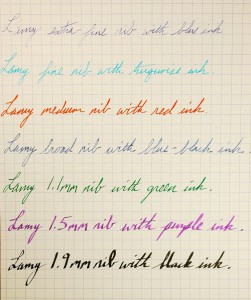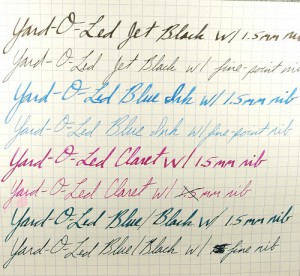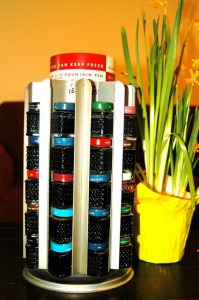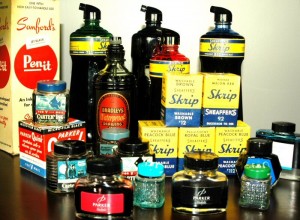A gentleman at this year’s Chicago Pen Show showed me his very elaborate ink-fast test to see which of his inks could best withstand direct sunlight for an extended period of time. He tested dozens, if not more than 100 inks, to see how they looked new, at 3 months, at 6 months and a year.
As he said most of the damage was done to the ink within the first three months, I decided to try a 3-month ink-fast test on my 8 favorite inks.
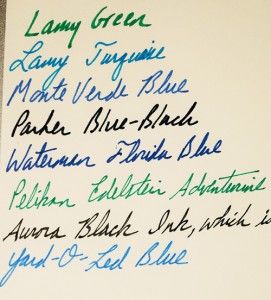
Here are the fresh fountain pen inks on Day 1 of the trial before being placed in my sunniest window.
Hopefully the photos show the results. However, to clarify any difficulties due to all of the variations of computer screens, I shall describe the results, as well.
Lamy Green went from a bright kelly green a faded, almost camouflage green-grey.
Lamy Turquoise turned to a blue-black.
Monte Verde’s new blue fountain pen ink faired second to worst, turning from a nice medium blue to a light shade of grey.
Parker Blue-Black fared best, maintaining a strong dark color more black than blue.
Waterman Florida Blue turned medium grey.
Pelikan Edelstein Adventurine, which is almost a forest green, but not quite, turned turquoise.
Aurora Black Ink turned a medium to darkish brown. This made me wonder if Aurora put a touch of iron in its ink.
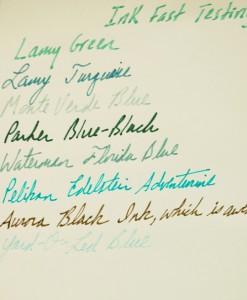
After 90 days in direct sunlight, all 8 inks faded. However, it appears that Parker Blue-Black ink held fastest and Yard-O-Led Royal Blue faded the most.
Yard-O-Led Royal Blue, which is an especially brilliant blue when fresh, fared worst and turned to a barely legible sky blue.
Although I had no idea how Waterman Florida Blue would deteriorate over the years, it has been my go-to ink since I discovered it in the 1990s. Now that they no longer make it and changed the formula to Parker’s slightly inferior blue Quink, I am on a quest for a new blue to love. I thought Yard-O-Led would be it, but now I have my doubts. A German friend has turned me on to Diamine Kensington Blue. We’ll have to see how that holds up to the sun.
When I know, I’ll be sure to share.


 Shopping Cart
Shopping Cart




